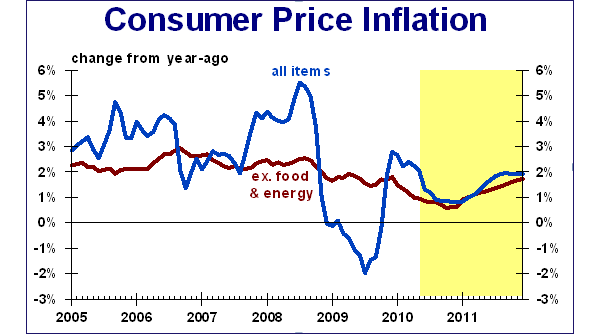Deflation? We Could Take a Sip
CPI drops have some alarmed. But falling prices are like booze: Fine in moderation, just not to be overdone.

With consumer prices falling for the second consecutive month in May, the prospect of deflation is provoking some angst. Thanks to recent weakness in food and energy prices, overall inflation for the most recent 12-month period has been a modest 2% -- slightly lower than the 2.5% pace averaged over the past decade.
Before inflation firms up next year, consumers are likely to enjoy further declines. More important, core inflation -- the rate of price increases for the 78% of products and services in the index that aren’t either energy or food -- is likely to continue to wane. That’s critical because food and energy prices can be notoriously misleading indicators when it comes to discerning inflation trends. During the commodity price boom of 2007-08, for example, inflation was a steep 5%, even though stripping out food and energy components yielded a “core” rate just half that level. Conversely, the commodity price collapse of 2008-09 resulted in prices falling 2% -- deflation -- while the core price measure still posted a modest 1.5% gain.
For the past 12 months, core inflation climbed a mere 0.9%, the lowest increase since 1966, and it’s headed still lower. One reason: Housing, which accounts for 31% of the Consumer Price Index. Even though house prices have stabilized over the past year, the glut of unoccupied homes and apartments is driving down rents, and that’s the way the government measures housing prices. It focuses on “rental equivalents,” or what properties would lease for on the open market. And because rents are renewed when leases expire, they tend to lag behind house prices by up to a year.
From just $107.88 $24.99 for Kiplinger Personal Finance
Become a smarter, better informed investor. Subscribe from just $107.88 $24.99, plus get up to 4 Special Issues

Sign up for Kiplinger’s Free Newsletters
Profit and prosper with the best of expert advice on investing, taxes, retirement, personal finance and more - straight to your e-mail.
Profit and prosper with the best of expert advice - straight to your e-mail.
As inflation drifts lower, the greater deflation fears will become. Policymakers, especially those at the Federal Reserve, worry about it because when falling prices persist, they are typically accompanied by falling wages, making debt burdens -- already onerous -- more difficult to carry. After all, debt levels don’t automatically adjust downward, and interest rates are about as low as we can realistically expect. So the burden of servicing existing debts eats up a larger and larger portion of diminishing real incomes. That was the story here in the 1930s and in Japan during the 1990s.
But flirting with deflation, and maybe even experiencing it briefly, isn’t necessarily bad. One reason is that wages tend to be “sticky” -- they adjust only gradually to changing circumstances. So when prices dip briefly but wages do not, the effect is to increase the purchasing power of people’s incomes. During the commodity price bust of 2008-09, for example, hourly wages were advancing at a modest 3.3% pace. But because prices fell 2%, that translated into an effective, or “real,” wage gain of 5.3%. Consumers benefited from falling prices, and spending didn’t shrink as much as it might have if real incomes were lower.
Another benefit of short-term deflation would come through its impact on interest rates. As a rule, part of the compensation that investors in fixed income securities require accounts for the risk of future inflation. But when deflation looms and the risk of inflation is seen as low, the risk premium declines and interest rates fall. That, of course, would buoy spending on big-ticket items, such as business equipment, houses and cars.
The bottom line is that persistent deflation poses some serious risks and it’s important not to be complacent about it. But as long as deflation isn’t overdone, we won’t end up with a hangover.

Profit and prosper with the best of Kiplinger's advice on investing, taxes, retirement, personal finance and much more. Delivered daily. Enter your email in the box and click Sign Me Up.

-
 Forget FIRE: Why ‘FILE’ Is the Smarter Move for Child-Free DINKs
Forget FIRE: Why ‘FILE’ Is the Smarter Move for Child-Free DINKsHow shifting from "Retiring Early" to "Living Early" allows child-free adults to enjoy their wealth while they’re still young enough to use it.
-
 7 Tax Blunders to Avoid in Your First Year of Retirement
7 Tax Blunders to Avoid in Your First Year of RetirementA business-as-usual approach to taxes in the first year of retirement can lead to silly trip-ups that erode your nest egg. Here are seven common goofs to avoid.
-
 How to Plan for Social Security in 2026's Changing Landscape
How to Plan for Social Security in 2026's Changing LandscapeNot understanding how the upcoming changes in 2026 might affect you could put your financial security in retirement at risk. This is what you need to know.
-
 What to Expect from the Global Economy in 2026
What to Expect from the Global Economy in 2026The Kiplinger Letter Economic growth across the globe will be highly uneven, with some major economies accelerating while others hit the brakes.
-
 Amid Mounting Uncertainty: Five Forecasts About AI
Amid Mounting Uncertainty: Five Forecasts About AIThe Kiplinger Letter With the risk of overspending on AI data centers hotly debated, here are some forecasts about AI that we can make with some confidence.
-
 Worried About an AI Bubble? Here’s What You Need to Know
Worried About an AI Bubble? Here’s What You Need to KnowThe Kiplinger Letter Though AI is a transformative technology, it’s worth paying attention to the rising economic and financial risks. Here’s some guidance to navigate AI’s future.
-
 Will AI Videos Disrupt Social Media?
Will AI Videos Disrupt Social Media?The Kiplinger Letter With the introduction of OpenAI’s new AI social media app, Sora, the internet is about to be flooded with startling AI-generated videos.
-
 What Services Are Open During the Government Shutdown?
What Services Are Open During the Government Shutdown?The Kiplinger Letter As the shutdown drags on, many basic federal services will increasingly be affected.
-
 The Economy on a Knife's Edge
The Economy on a Knife's EdgeThe Letter GDP is growing, but employers have all but stopped hiring as they watch how the trade war plays out.
-
 Apple Readies for AI Upgrade with New iPhones
Apple Readies for AI Upgrade with New iPhonesThe Kiplinger Letter The tech giant has stumbled when it comes to artificial intelligence, but a new batch of iPhones will help it make headway.
-
 Japan Enters a New Era of Risk and Reform
Japan Enters a New Era of Risk and ReformThe Kiplinger Letter Japan has entered a pivotal moment in its economic history, undertaking ambitious policy and structural reforms to escape from decades of stagnation.